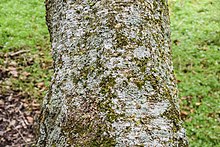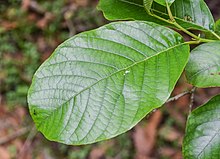Comments
provided by eFloras
The wood is light and soft and is used for making inexpensive furniture and boxes.
- license
- cc-by-nc-sa-3.0
- copyright
- Missouri Botanical Garden, 4344 Shaw Boulevard, St. Louis, MO, 63110 USA
Description
provided by eFloras
Trees to 15 m tall; bark gray or dark gray, smooth. Branchlets dark brown, sparsely yellow pubescent when young, glabrescent. Buds stipitate, with 2 glabrous, ribbed scales. Petiole robust, 1-2.5 cm, subglabrous; leaf blade obovate-lanceolate, obovate-oblong, ovate, or elliptic, 4-16 × 2.5-10 cm, abaxially with dense, resinous glands, yellow pubescent along veins, bearded in axils of lateral veins, adaxially glabrous, base cuneate or broadly cuneate, rarely subrounded, margin entire or remotely minutely serrate, apex abrupt or acute, rarely acuminate; lateral veins 8-16 on each side of midvein. Female inflorescences numerous, in a panicle, ellipsoid, 2-2.2 cm × 7-8 mm; peduncle robust, 2-8 mm, glabrous; bracts ca. 4 mm, woody, persistent, base cuneate, apex rounded, 5-lobed. Nutlet oblong, ca. 2 mm, with membranous wings ca. 1/2 as wide as nutlet. Fl. May-Jun, fr. Jul-Sep. 2n = 28, 56.
- license
- cc-by-nc-sa-3.0
- copyright
- Missouri Botanical Garden, 4344 Shaw Boulevard, St. Louis, MO, 63110 USA
Distribution
provided by eFloras
Guangxi, Guizhou, SW Sichuan, Xizang, Yunnan [Bangladesh, Bhutan, India, Myanmar, Nepal, Sikkim, N Thailand, N Vietnam]
- license
- cc-by-nc-sa-3.0
- copyright
- Missouri Botanical Garden, 4344 Shaw Boulevard, St. Louis, MO, 63110 USA
Distribution
provided by eFloras
Himalaya (Garhwal to Bhutan), Assam, Tibet, Burma, Indo-China, W. China.
- license
- cc-by-nc-sa-3.0
- copyright
- Missouri Botanical Garden, 4344 Shaw Boulevard, St. Louis, MO, 63110 USA
Elevation Range
provided by eFloras
500-2600 m
- license
- cc-by-nc-sa-3.0
- copyright
- Missouri Botanical Garden, 4344 Shaw Boulevard, St. Louis, MO, 63110 USA
Habitat
provided by eFloras
Riverbanks or village margins, often forming pure stands; 200-2800 m.
- license
- cc-by-nc-sa-3.0
- copyright
- Missouri Botanical Garden, 4344 Shaw Boulevard, St. Louis, MO, 63110 USA
Synonym
provided by eFloras
Alnus boshia Buchanan-Hamilton ex D. Don; Clethropsis nepalensis (D. Don) Spach.
- license
- cc-by-nc-sa-3.0
- copyright
- Missouri Botanical Garden, 4344 Shaw Boulevard, St. Louis, MO, 63110 USA
Cyclicity
provided by Plants of Tibet
Flowering from May to June; fruiting from July to September.
Diagnostic Description
provided by Plants of Tibet
Alnus nepalensis is close relative of Alnus henryi, but differs from the latter in its female inflorescences numerous (vs. 5-13), nutlet with membranous (vs. papery) wings, leaves entire or remotely minutely serrate (vs. serrate).
Distribution
provided by Plants of Tibet
Alnus nepalensis is occurring in Guangxi, Guizhou, SW Sichuan, Xizang, Yunnan of China, Bangladesh, Bhutan, India, Myanmar, Nepal, Sikkim, N Thailand, N Vietnam.
Evolution
provided by Plants of Tibet
Phylogeny of Alnus was inferred from nuclear ITS region (Navarro et al., 2003). Molecular phylogeny shows that all species of the genus Alnus form a monophyletic group close to Betula and that the fundamental dichotomy within the genus lies between the subgenera Alnaster and Gymnothyrsus, sensu Murai. The subgenus Alnaster appears to be basal in the genus, based on archaism of morphological features, and branching close to the root of the trees due to low ITS divergence from genus Betula. Alnus nepalensis is positioned in the subgenus Gymnothyrsus, away from A. nitida and A. maritima.
General Description
provided by Plants of Tibet
Trees to 15 m tall; bark gray or dark gray, smooth. Branchlets dark brown, sparsely yellow pubescent when young, glabrescent. Buds stipitate, with 2 glabrous, ribbed scales. Petiole robust, 1-2.5 cm, subglabrous; leaf blade obovate-lanceolate, obovate-oblong, ovate, or elliptic, 4-16 cm long, 2.5-10 cm wide, abaxially with dense, resinous glands, yellow pubescent along veins, bearded in axils of lateral veins, adaxially glabrous, base cuneate or broadly cuneate, rarely subrounded, margin entire or remotely minutely serrate, apex abrupt or acute, rarely acuminate; lateral veins 8-16 on each side of midvein. Female inflorescences numerous, in a panicle, ellipsoid, 2-2.2 cm long, 7-8 mm wide; peduncle robust, 2-8 mm, glabrous; bracts ca. 4 mm, woody, persistent, base cuneate, apex rounded, 5-lobed. Nutlet oblong, ca. 2 mm, with membranous wings ca. 1/2 as wide as nutlet.
Genetics
provided by Plants of Tibet
The chromosomal number of Alnus nepalensis is 2n = 28, 56 (Mehra, 1976; Sandhu and Mann, 1989).
Habitat
provided by Plants of Tibet
Growing in riverbanks or village margins, often forming pure stands; 200-2800 m.
Uses
provided by Plants of Tibet
The wood of Alnus nepalensis is light and soft and is used for making inexpensive furniture and boxes.
Alnus nepalensis
provided by wikipedia EN
Alnus nepalensis is a large alder tree found in the subtropical highlands of the Himalayas. The tree is called Utis in Nepali and Nepalese alder in English. It is used in land reclamation, as firewood and for making charcoal.
Description
Alnus nepalensis is a large deciduous alder with silver-gray bark that reaches up to 30 m in height and 60 cm in diameter. The leaves are alternate, simple, shallowly toothed, with prominent veins parallel to each other, 7–16 cm long and 5–10 cm broad. The flowers are catkins, with the male and female flowers separate but produced on the same tree. The male flowers are 10 to 25 cm (4 to 10 in) long and pendulous, while the female flowers are erect, 1 to 2 cm (0.4 to 0.8 in), with up to eight together in axillary racemes.[2] Unusually for an alder, they are produced in the autumn, with the seeds maturing the following year.
Distribution
It occurs throughout the Himalaya at 500–3000 m of elevation from Pakistan through India, Nepal and Bhutan to Yunnan in southwest China. It grows best on deep volcanic loamy soils, but also grows on clay, sand and gravel. It tolerates a wide variety of soil types and grows well in very wet areas. It needs plenty of moisture in the soil and prefers streamside locations, but also grows on slopes.[3]
Uses
The tree grows quickly and is sometimes planted as erosion control on hillsides and for land recovery in shifting cultivation. It has nodules on the roots which fix nitrogen. The wood is moderately soft. It is occasionally used for making boxes and in light construction but is mainly used as firewood, when it burns evenly but rather rapidly, and for making charcoal. Currently, this tree species is preferred by different indigenous ethnic groups such as H'mong, Nung and Thu Lao in Simacai district, Lao Cai province, Northern Vietnam to regreen and enrich the forest by local knowledge (SPERI, CENDI).[2]
References

- license
- cc-by-sa-3.0
- copyright
- Wikipedia authors and editors
Alnus nepalensis: Brief Summary
provided by wikipedia EN

Bark of Alnus nepalensis

Leaf of Alnus nepalensis
Alnus nepalensis is a large alder tree found in the subtropical highlands of the Himalayas. The tree is called Utis in Nepali and Nepalese alder in English. It is used in land reclamation, as firewood and for making charcoal.
- license
- cc-by-sa-3.0
- copyright
- Wikipedia authors and editors


 Bark of Alnus nepalensis
Bark of Alnus nepalensis  Leaf of Alnus nepalensis
Leaf of Alnus nepalensis